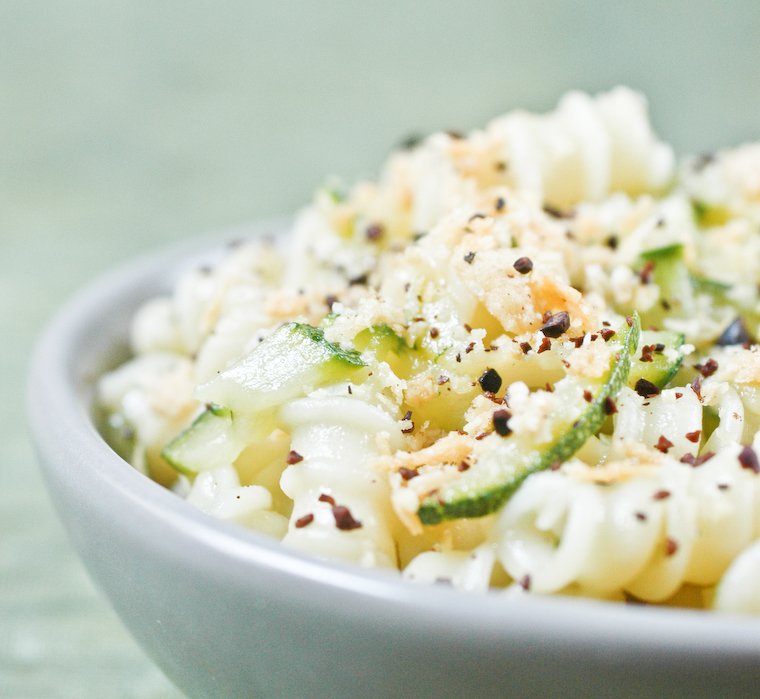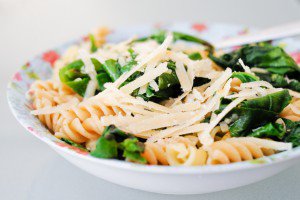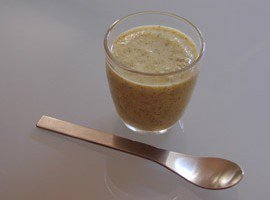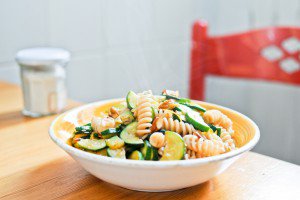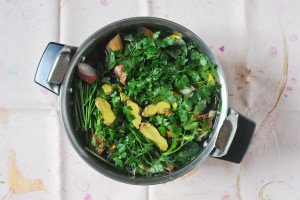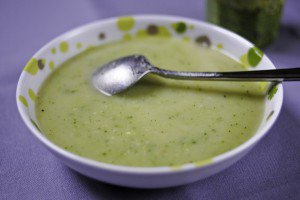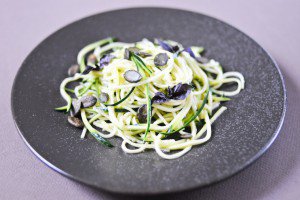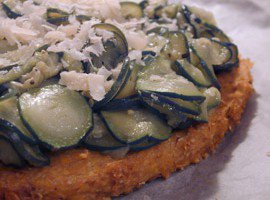Chose promise, chose due*, here is my take on absorption pasta, or risotto-style pasta. The idea of this technique is to coat the pasta with a little olive oil, add just enough liquids to cover, and cook until desired tenderness. According to Virka — who read it in the Italian paper La Reppublica so it simply must be true — this cooking technique dates back from the early 13th century, and was in fact the only one that was used before it was displaced by the now-classic boiling method.
For this first trial, I used the ricciole pasta that came in my package of Italian goodies, and followed Pascale’s instructions as a guide. I didn’t have stock on hand — I am a bad, bad person — so I just used filtered water: the flavor was fine, but will of course be richer if you use homemade stock, you Martha Stewart you. The pasta was cooked with thin sticks of zucchini (cut with my mighty mandoline — no fingers were sliced in the process, I’m getting better at this), and received a sprinkle of crushed cacao nibs and crispy flecks of aged Parmesan just before serving.
The crispy flecks of Parmesan are a fortuitous by-product of my recent attempt to make Parmesan wafers with the previously featured hunk of 3-year-old Parmigiano Reggiano. It turns out that this Parmesan is marvellous, yes, but much too dry and much too proud to let itself be turned into a vulgar wafer: the grated cheese didn’t so much melt as grill, and my golden circles just crumbled into bits when I tried to lift them from the baking sheet. Said bits were delicious however, so they were promptly recycled into sandwich garnishes and canapé toppings.
Anyway, where were we? Ah yes, the absorption pasta. So, how was it? It was lovely, that’s how it was — so lovely in fact, that I might stick to that technique from here on in. First of all, and however odd this may sound, I hate bringing pots of water to a boil — it is the most boring thing in the world. Since I am an impatient cook, I cannot help but lift the lid every ten seconds and, as we all know, watched water never boils, which is kind of a problem, especially when you’re hungry and thus cranky.
Secondly, the absorption method makes it easier to test the pasta for doneness: when you pluck one from the pan, you can taste it (almost) straight away, since it isn’t as scorching hot as when you lift it from a pot of boiling water. And once you have reached the consistency that you like, the pasta can go straight from the pan into your plate, without continuing to cook as it does when you have to drain it and toss it with the sauce. Finally, and more to the point, this technique allows a delectable coating of starch to develop around the pasta, giving it a toothsome, silky texture.
As the pasta softly simmered, I was quite surprised to notice that a scent of almonds wafted up from the sauté pan: I am not entirely sure whether that came from my olive oil, from the pasta itself, or a happy alchemy between the two, but I had never had that happen before. This scent had somewhat subsided by the time the pasta was cooked, but it was still a lingering presence in the finished dish, and went delightfully well with the softened zucchini, the toasty flecks of Parmesan, and the earthy crunchy cacao nibs**.
* Chose promise, chose due means “a promise is a debt.”
** Cacao nibs (éclats de fève de cacao in French) are tiny bits of rosted cacao beans, not sweetened or processed any further. They have an intense chocolate scent, and they are crunchy and nutty.

Have you tried this? Share your pics on Instagram!
Please tag your pictures with #cnzrecipes. I'll share my favorites!
Ingredients
- 2 tablespoons virgin olive oil
- 2 garlic cloves, peeled and minced
- 200 grams (3.5 ounces) short pasta, such as penne, fusilli or ricciole (use gluten-free as needed)
- Up to 720 ml (3 cups) very hot stock (or filtered water)
- 1 medium zucchini, cut into thin sticks
- Salt, freshly ground pepper
- 1 tablespoon cacao nibs (not chocolate coated), optionally toasted in a dry skillet, and coarsely crushed with a mortar and pestle
- Freshly grated Parmesan (substitute nutritional yeast to veganize)
Instructions
- Heat the oil in a large sauté pan. Add the garlic, and cook for 1 minute over medium heat, stirring regularly, until fragrant. Add the pasta, and stir continuously for 2 minutes.
- Add stock or water to just barely cover the pasta, and lower the heat to medium-low. Cover, and simmer for 10 minutes, stirring from time to time.
- 5 minutes into the cooking, add the zucchini, and sprinkle with salt and pepper.
- Taste the pasta for doneness: if it isn't quite done and all the liquids have been absorbed, add a little more stock or water, cover, and cook for a few more minutes before tasting again.
- Adjust the seasoning. Transfer into a bowl, sprinkle with cacao nibs and Parmesan, and serve.


